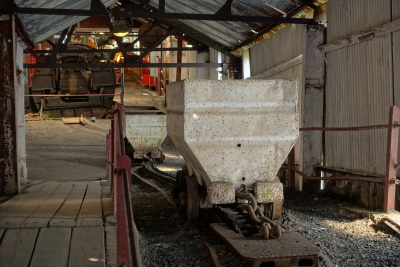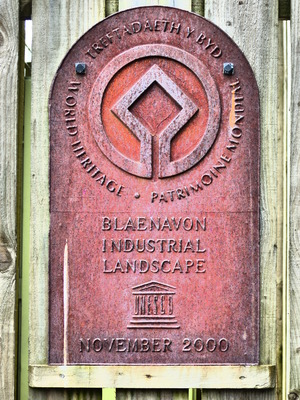Blaenavon Industrial Landscape

The Blaenavon Industrial Landscape resulted from the early production of iron and coal in its mines and ironworks, which were driving forces of the Industrial Revolution.
This area in South Wales shows a remarkably complete example of a late 18th and 19th century industrial complex, that included mines, manufacturing, methods of transport (railway, canal), and housing for the workers. The Big Pit (1880), a deep coal mine, has remained in use until 1980.
Community Perspective: The Big Pit underground tour is the main attraction here. Blaenavon Ironworks is also worth visiting. Be aware that the site can be hard to access on public transport on Sundays and that severe weather conditions can lead to the closure of the Big Pit.


Map of Blaenavon Industrial Landscape
Load mapCommunity Reviews
Jakob Frenzel

March 2018 - Again bad luck. We arrived in the evening. Blaenevon was piled with snow, very wet snow. Somehow we managed to walk through the town and see the WHS buldings.
Next morning we wanted to visit the Big Pit. Due to severe whether conditions it was closed. Not only that one day but probabaly the whole week. We took some pictures of the mine and went back to England to see the next Whs,
Jay T

About halfway through my very rainy drive from London to the Blaenavon Industrial Landscape in Wales earlier this month, I had to remind myself BBC weather predicted clearing skies by the time I would arrive at Blaenavon. Fortunately, the weather forecast was correct, and I was able to enjoy some sun for an hour in the town before driving to the Big Pit to descend into the depths of the former coal mine. One of the best things about visiting Blaenavon is that entrance to both the Blaenavon Ironworks and the Big Pit is free, and the former miners giving the tours of the coal mine were knowledgeable and amusing (and good singers, which I suspect is a requirement for being Welsh) as they discussed the hardships of the coal mining industry. On my tour was a friendly Welsh couple who gave context to how the coal mining at Blaenavon benefited the copper industry near their city of Swansea. After touring the Big Pit, I continued to the Ironworks, where I learned the story of Sidney Gilchrist Thomas, who, with his cousin Percy, conducted experiments at Blaenavon in the 1870s and learned how to remove phosphorus from iron to produce steel. While this process was revolutionary, ultimately it led to the rise of the coal and steel industry in mainland Europe at the expense of the industry in Wales. Although not the biggest fan of mines, I learned a lot from my visit to Blaenavon.
Logistics: Blaenavon is an easy two and a half hour drive from London, and it is relatively easy to walk between the Ironworks and the visitor center in town; the Big Pit can be reached on foot from the Ironworks or faster by car.
Clyde

I visited this WHS in June 2016. The Big Mine has been closed for the last couple of months because of a general strike. Luckily an agreement has been reached and access to the pit should be back to normal soon. However, if you happen to visit on a sunny day I'd suggest you visit the Blaenavon Iron Ore Mountains in the Brecon Beacons National Park from where the iron ore was sourced. The surrounding natural environment has fully recovered and there are several sheep, lambs, badgers, ponds, etc. for an enjoyable hike. Just be careful while driving as you're likely to find sheep crossing the road or just lazing about. A visit to the Blaenavon Ironworks is a must. Not only because of the official UNESCO plaque (and a beautiful manhole commemorating Blaenavon's inscription in English and Welsh), but also because of the interesting 'vintage-looking' information boards, the museum-like cottages from 1790 to the 20th century and the audiovisual presentation (picture). In brief, the workers prepared coke, Blaenavon rocks or iron ore and limestone in the upper yard above the blast furnaces. Then they tipped them from above and used the engines to blow in air through a network of pipes. At more than 1500 degrees Celsius, the iron melted and the molten iron was 'tapped' and guided into channels in the sand to form iron pigs. The workers then drained the waste slag and transported it away in trams. I was lucky to visit on World Heritage Day and not only was the entrance to the ironworks free but there was also a small fair in town where I bought some lamb pastries. Having visited quite a number of mines, I didn't miss not wearing a hard hat for once but if you have the time or you happen to visit on a wet day, go for it.
Tom Livesey
I went to Blaenavon in June 2013. From Abergavenny station my friend and I took a taxi up the steep steep hill to Blaenavon. The main attraction of the town is the Big Pit mine, which is a former coal mine that operated until 1980.
You can go down the pit on a guided tour with a real ex-miner, and it’s all free, so well worth doing. The miners have adapted well to being tour guides, and have a real bonhomie with the visitors. We were given hard hats with headlamps to put on, as well as a belt with a battery and a carbon monoxide safety device. Coming out of the cool, dank mine was a (literal) breath of fresh air, as the weather was unusually – for Wales – warm and the sky blue.
After Big Pit we headed off toward the village itself to see the ironworks. We were stopped along our way by the sight of a brewery that had a “self-tour” available, including a sample of ale all for £2.50.
At the ironworks they used to smelt the iron ore that was dug out of Big Pit, turning it into useful iron products. The mill employed 5000 people at its peak.
Klaus Freisinger
Although I'm generally not a big fan of industrial sites, I quite enjoyed my visit to Blaenavon. It is a pretty town in South Wales that can be reached by bus from Newport in about an hour. The main attraction is the Big Pit with the associated National Coal Museum, which was a working coal mine from the mid-19th to the late 20th century. Nowadays, there are very interesting underground tours guided by former miners. The complex includes several exhibitions about the mines and the often miserable lives of the miners. The Big Pit is about a 20-minute walk from the centre of Blaenavon village; attractions in the centre itself include the remains of the ironworks and several historic buildings associated with mining. The best thing is that since the Big Pit is part of the National Museums of Wales, entrance is free. So all in all, it was a very pleasant excursion on a warm summer day.
Frederik Dawson

Really sorry for the people of Blaenavon, but for me Blaenavon is become the synonym of one misfortunate after the other in my life as my visit to this place is a collection of unfortunate events. I started my visit on the bright and clear sky day from Bristol, when I reached Newport train station and walked to the bus station, it started to rain, and it was really a heavy rain so that the bus driver had to stop the bus for a while as he could not see the road.
The driver promised that we will reach Blaenavon as soon as possible, when he resumed the journey in the thick mist. The invisible view along the way was amazing like we drove in the cloud. When the bus reached Blaenavon area, the view was visible again with the stunning rolling hills of green grass which I really enjoyed, but suddenly the bus parked again as there was a big funeral procession in front of the church and then it started to rain again, and few minutes later it was snow! I walked in the snow with unprepared cloth aiming to reach Big Pit Mining Museum; however, snow was so heavy that I could not see the way and I urgently need a warm shelter. I ended up at the hotel restaurant and stuck in there with three cups of hot drink for almost three hours. I walked to see the Ironwork and discovered that the place was under snow and the gate was closed. After many unfortunate events I decided I better to return to Bristol, so I walked to the bus stop in the town center which maybe the only part of UNESCO listed area I have been.
The sun almost gone when I reached Newport, and again with my silliness, I took a wrong train and ended up in Gloucester before finally could find a right train back to Bristol. I promised to myself that if I have a chance to come to southern Wales again, I definitely will try to visit Blaenavon again, but I may have to bring some lucky charms with me.
John booth

At the ironworks I was fascinated by the tiny cottages that had been restored in Stack Square and Engine Row. Nearby are the giant smelters where the ore was converted into metal and waste.
Ian Cade

I managed to fit this in to a long day trip with breakfast at Stonehenge, lunch in Bath and getting to Bleanavon for the last tour of the day! Bleanavon makes a lot out of its UNESCO status there were banners all through the town and it was nice to see as many places in Britain don't make much of a big deal of it!
But there is a fair bit to see here the main site "Big Pit" is interesting as you get to go into the mines with the people that used to work there as your guide. There seems to be a really community feeling to the valleys of South Wales, and it was not a surprise to find that the whole thing is free!!! Especially in an area of Britain where Socialist morals were once so strong.
It is easy to drive to Blaenavon as it is easily marked from the M4 which runs from London, if you do not have a car apparently the No 30 & 23 buses run every 30 minutes from Newport (easy to get to from Cardiff). If you are in the area it is worth exploring Cardiff which is rapidly becoming a major cultural centre in Britain and also if you carry on about 5 miles north of Blaenavon you are in the Brecon Beacons which are one of the nicest natural areas in the British Isles, ideal for hiking and camping
Amy
I visited Blaenavon's Big Pit on a school trip. I found it very interesting to actually see what it was like for miners when they had to work in the dark, damp and dusty environment. We had to go underground in a sort of cage lift. At one piont we had to turn off our lights, it was pitch black!!! Children had to work in these conditions every single day for upto around ten hours. i just wouldn't have coped. Any way it is a very memorable experience and you should vist it yourself (if you haven't already!)have fun!!!!
Els Slots
Blaenavon is a small town in the green hills of Wales. The surrounding countryside is a great place for hiking. I went to the old coal mine instead and took the underground tour. The tours at the Big Pit are led by ex-miners and take about an hour.
Before your visit underground, you get a sturdy helmet with a light in front. Off you go then, in the elevator 90 meters downwards. It's dark and cool. Water is dripping. The tunnels you walk in most of the time are just a bit too low to stand upright.
At one moment, our guide asked us to switch our lights off. It became as dark and scary as it can get. To hear that there used to run rats here and that children as young as 7 or 8 were employed under the ground, with no light but the odd candle, makes you really think ...
Community Rating
- : Thomas Harold Watson Anne
- : Dimitar Krastev Westwards Can SARICA Jezza Matthewgibbs
- : Christravelblog Ssong.x Fozzak MH James Bowyer Digits Laurine
- : Szucs Tamas Gary Arndt George Gdanski Randi Thomsen Alexander Lehmann Hanming Ralf Regele Daniel C-Hazard Shandos Cleaver Cezar Grozavu Leslieisthebest BenReeve Frédéric M Philipp Peterer
- : Zoë Sheng Jakob Frenzel Nan Craig Harder Adrian Turtschi Jeanne OGrady Hubert Jay T Argo Klaus Freisinger Allan & Lucia Andrew_Kerr Squiffy Svein Elias Els Slots
- : Martina Rúčková Philipp Leu Clyde Frederik Dawson Caspar Dechmann Ian Cade Sachin Solivagant Ivan Rucek ChrisN
- : Wojciech Fedoruk Doubanjiang Dirk-pieter
- : Mike
- : Tarquinio_Superbo
Site Info
- Full Name
- Blaenavon Industrial Landscape
- Unesco ID
- 984
- Country
- United Kingdom
- Inscribed
- 2000
- Type
- Cultural
- Criteria
-
3 4
- Categories
- Cultural Landscape - Relict Structure - Mines
- Link
- By ID
Site History
2000 Inscribed
Site Links
Unesco Website
Official Website
In the News
Connections
The site has 21 connections
Constructions
Human Activity
Science and Technology
Timeline
Visiting conditions
WHS Hotspots
WHS on Other Lists
World Heritage Process
Visitors
194 Community Members have visited.
The Plaque
 (photo by Clyde)
(photo by Clyde)